Aktuell:
VIERTE PILGERREISE/STADT-RETREAT ALS ZEN PEACEMAKERIN NACH SIZILIEN – VOM 6.-13.4.2022
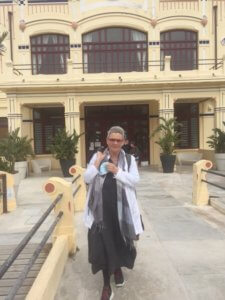 Reflektionen zur Pilgerreise nach Palermo vom 13.-20.4.2022, wo ich auch meinen 70sten Geburtstag zusammen mit meiner Schwester gefeiert habe. Insgesamt handelte es sich um die 4. Pilgerreise nach Lampedusa/Sizilien/Kalabrien bzw. um die 5., wenn ich die zehntägige Nicht-Wissen-Reise nach Athen/Piräus miteinbeziehe. Diese wurde von Petra Zenryu Hubbeling organisiert und führte uns täglich in ein Flüchtlingslager am Hafen. – Insgesamt ging es mir und meinen jeweiligen Mitreisenden darum, Zeugnis abzulegen von dem Schicksal, dem Leid und den Hoffnungen und Freuden derer, die das Mittelmeer nach Europa, als Migranten*innen oder Geflüchtete, überquerten, ihren Angehörigen und von den Helfern*innen jeweils vor Ort: Auf den Booten, den Fischerbooten der Retter, den Rettungsschiffen, in Häfen, Hotspots, Lagern, in Unterkünften, auf Friedhöfen.
Reflektionen zur Pilgerreise nach Palermo vom 13.-20.4.2022, wo ich auch meinen 70sten Geburtstag zusammen mit meiner Schwester gefeiert habe. Insgesamt handelte es sich um die 4. Pilgerreise nach Lampedusa/Sizilien/Kalabrien bzw. um die 5., wenn ich die zehntägige Nicht-Wissen-Reise nach Athen/Piräus miteinbeziehe. Diese wurde von Petra Zenryu Hubbeling organisiert und führte uns täglich in ein Flüchtlingslager am Hafen. – Insgesamt ging es mir und meinen jeweiligen Mitreisenden darum, Zeugnis abzulegen von dem Schicksal, dem Leid und den Hoffnungen und Freuden derer, die das Mittelmeer nach Europa, als Migranten*innen oder Geflüchtete, überquerten, ihren Angehörigen und von den Helfern*innen jeweils vor Ort: Auf den Booten, den Fischerbooten der Retter, den Rettungsschiffen, in Häfen, Hotspots, Lagern, in Unterkünften, auf Friedhöfen.
Über meine “Geburtstagspilgerreise” nach Palermo im April 2022
Motivation und Einbettung in die vorherigen Pilgerreisen – Warum Palermo? – Welche Spuren menschlicher Begegnung mit Geflüchteten konnten wir finden? – Die verschwundene Synagoge von Palermo.
Lesen Sie auch die Blog-Beiträge zum Thema “Palermo”. Schreiben sie mir, wenn Sie Fragen haben. Grazie tanto!
Blogbeiträge:
- “Moltivolti” Palermo, 28.04.2022
-
Palermo und die Geflüchteten, 26.05.2022
-
Palermo – eine Geburtstagspilgerreise, 09.06.2022
- The Palermo-birthday-pilgrimage, April 13-20, 2022 (english version)
Diese ausgezeichnete Reportage von arte drückt alles und besser aus, warum ich in Palermo war.
Lampedusa, oh Lampedusa*
My heart rejoices hearing of all who made it across the sea.
My heart breaks knowing that many have not made it and will not make it and their bodies will feed fishes.
And my heart breaks for all the beloved ones, the families, the fathers and mothers and siblings, the grandparents, the villages, who set their hope on the one, leaving for a dignified future.
My heart breaks for Lampedusans, who are witnessing, almost day after day, living on a very small island, which geologically is closer to Africa than to Sicily, the often weak boats crowded by African sisters and brothers.
Not seldom did they see a comrade fall into the vast waters. And falling often means dying, because Africans cannot swim.
Many have wounds, burning wounds by the mix of salty water and oil. Women are far too often raped, the doctor of Lampedusa has written a book about what he has been seeing and trying to “heal”, if just by friendliness, good words, a comforting hand. Dehydrated, hungry, exhausted is everybody, on arrival. On setting foot on European soil.
I have met my black relatives from Africa crossing the very deep sea to reach Lampedusa:
– In Lampedusa and Sicily
– in Bonn
– in the streets of Paris, during my last street retreat in 2019, with Michael Genko Roshi.
They told me that conditions in Paris and France were better than in Germany for refugees
And I will never forget what I heard and saw and read and what I listened to.
I wish to include into this sharing contemplation, this song, to include my Syrian friends, here.
Their flights are a bit different and each and every person had another and very unique journey, until we met. Until we would sit side at side, and one of us listened and the other talked.
There were other nationalities, I have sat with together in grieving circles:
– from Pakistan and Irak
– from Marocco
Most people I could make friends with are from Syria. Feeling love and gratitude for our yearlong process of accompanying each other.
Feeling close to you.
Feeling also close to the dead. Not many are buried on a cemetary, but we testified to some cemetaries, in Southern Italy, in Northern Sicily, on Lampedusa.
Testifying to the sea, which always took lives.
But the shere amount of black bodies in the last decade…exceeds our ability to imagine.
Women, pregnant women, babies, young and older children, teenagers, included.
This story is part of our story as humans.
Let us not forget those on flights just now.
Those in camps, many of them have turned into slums, also in Europe.
Do we feel responsible, in any ways?
What can we be and do for our children and their children?
What is our stand towards our own weapon industry? Digitalization? Our contribution to: Destruction by man-made weather-conditions.By pollution of water, air, soil. Hunger. War. Flights.
When we die: What are we going to repent?
Is our whiteness something, we might really and deeply feel and use as fuel to repair the world?
That we live and how we live is an exception, is extremely privileged!
Are we accountable?
May all beings be happy, may they be saved.
(*I have created and organized, with considerable help by Morena Poltroni, the first bearing-witness-pilgrimage to Lampedusa in 2014, in 2017 the second one, in 2020 the third one to Sicily and Southern Italy, to an International migrants’ cemetery and other cemeteries.
A not-knowing-pilgrimage with Petra Zenryu Hubeling to Piraeus/Greece and daily stays in a refugees’ camp in 2016 gave us a vivid idea how mainly Syrian, but also refugees from Afghanistan, Irak and others were living, who was supporting them, what was most needed.
My beloved Syrian Curdish Family I have gladly visited several times in Northern Germany, was the first, inviting me into their circle of tents in Piraeus.)
Blog
- The Palermo-birthday-pilgrimage, April 13-20, 2022 (english version)
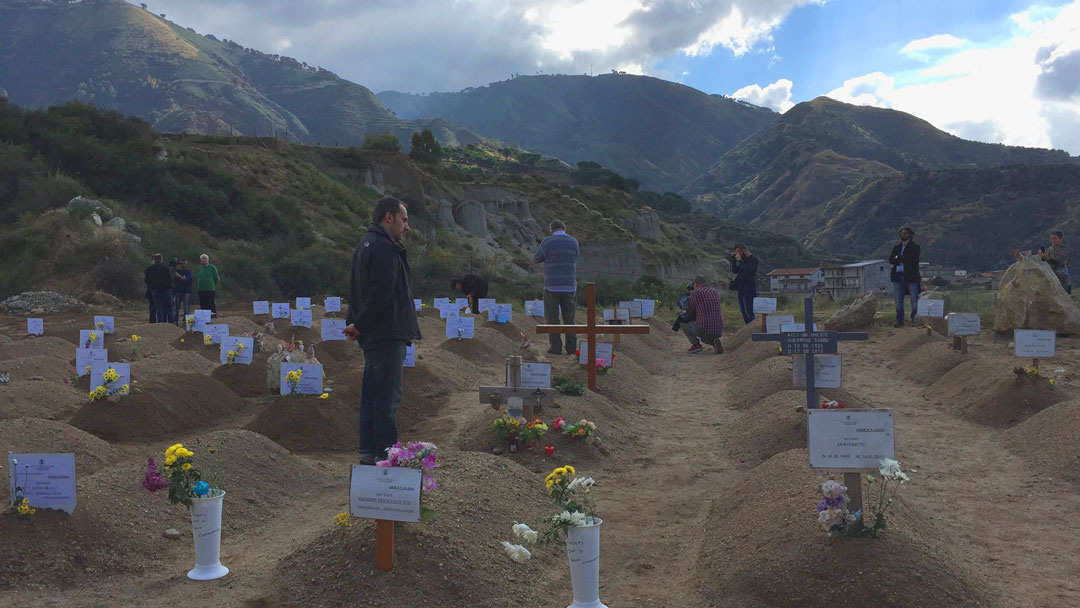
Bericht von der Pilgerreise nach Sizilien und Kalabrien Januar 2020
Unschuldige Augen
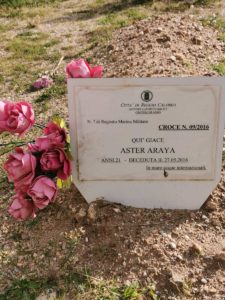 Vom 07. bis 14.01.2020 haben drei Frauen eine Pilgerreise nach Süditalien unternommen: Genauer gesagt, war das Ziel ihrer Reise der Internationale Friedhof in Tarsia/Kalabrien, der im Internet nur wenige Anhaltspunkte hergab.
Vom 07. bis 14.01.2020 haben drei Frauen eine Pilgerreise nach Süditalien unternommen: Genauer gesagt, war das Ziel ihrer Reise der Internationale Friedhof in Tarsia/Kalabrien, der im Internet nur wenige Anhaltspunkte hergab.
Diese Frage hatte mich schon bewegt, als ich die Fotos in den Nachrichten sah, 2014, Fotos von mit Särgen dicht an dicht gefüllten Hallen, auf denen rote Rosen lagen. Lange konnte man das auf Lampedusa nicht durchhalten, jedem einzelnen Ankömmling einen Sarg, ein Grab zu geben. Ich spreche jetzt von ein paar wenigen Eindrücken von der ersten Zeugnis-Ablegen-Reise nach Lampedusa, im September 2014, einen Monat vor dem Jahrestag des schrecklichen Bootsunglücks ganz nah an der Küste der Insel. Circa 350 Menschen, darunter auch Babys und Kinder, waren am 03.10.2013 im Morgengrauen ertrunken. Ein Fischer, der zufällig draußen auf dem Meer war, rettete mit zwei Freunden Dutzende. Wir sollten ihn kennenlernen und mit ihm sprechen. Die Bürgermeisterin Sgra. Guisi Nicolini hielt bei ihrer Ernennung als Bürgermeisterin von Lampedusa eine bewegende Rede, in der die über das Meer Flüchtenden eine zentrale Rolle einnahmen. (Die Rede wird hier bald zum Download bereitstehen.) Als wir auf dem Friedhof waren, um Gehmeditation zu machen oder still zu sitzen und zu beten, die Grabinschriften zu kontemplieren, konnte man nach einer Weile gut nachvollziehen, wie aufrichtig bemüht Lampedusaner noch zu Beginn – wann immer man den Beginn datiert – gewesen waren, zu dokumentieren, wer in welchem Alter wo im Meer umgekommen war. Sehr berührende Dokumente der Anteilnahme und sozusagen einer umgekehrten Gastfreundschaft waren hier – und sind es sicherlich immer noch – auf den Grabsteinen zu sehen. Doch natürlich würde das ein Ende haben, die Insel ist klein, der Friedhof auch. Es gab Übergänge, Gräber mit mehreren Namen, bis hin zu einem winzigen Feld und einem Holzkreuz. Wenn dieses Holzkreuz sprechen könnte …
Sie, liebe Leserinnen und Leser, erahnen jetzt schon, wie sich Puzzleteil auf Puzzleteil häufte, wie meine Frage, wohin die Särge eigentlich gebracht würden, unbeantwortet blieben, wie mich die erschütternden Aussagen von jungen geflüchteten Männern in Bonn bewegten, welche immer wieder berichteten, dass Mütter, Tanten, meist in der Nacht, anriefen und nach ihren Söhnen fragten! Wenn sie überhaupt erfuhren, ob ihr Kind noch am Leben war oder nun mit Sicherheit wussten, dass es gestorben war – sie wollten unbedingt erfahren, wo dieser geliebte, vermisste Mensch, ihr Kind, begraben wurde! Die syrischen Freunde, die ich traf, mit manchen von ihnen verband oder verbindet mich Freundschaft, waren erschöpft von diesen Telefonaten oder anderen, auch die wenigen schönen Anlässe erschöpften sie (Geburtstagsfeiern, Hochzeiten), denn sie konnten ja nicht dabei sein.
Im Januar 2020 wurde mir, nach vielen Gesprächen mit offenen, hilfsbereiten (außer einem, in einer Bar in Reggio) Italienern klar, dass diese Fragen – obwohl wir stets unsere Dankbarkeit beteuerten und aufzählten, was die Süditaliener uns aus dem Norden alles abnehmen würden –, dass diese Fragen ein Tabu darstellten.
Erst am vorletzten Tag unserer Abreise würden sich Puzzleteile dessen, was wir erfahren oder beobachtet hatten, in sinnvoller Weise zusammensetzen. Da waren wir inzwischen auf zahlreichen Friedhöfen gewesen und hatten uns umgeschaut. Einer der Friedhofsangestellten wusste etwas zu berichten, das er mir anvertraute. Ein junger Angestellter in der Bar am Hotel nahe Tarsia äußerte eine Fantasie. Und nicht zuletzt die aufklärenden Gespräche rund um den alten und neu geplanten Friedhof in Tarsia: All dies plus ein Artikel im SPIEGEL, der plötzlich auf meinem Handy landete und den ich im gemieteten Auto vorlas, gaben deutliche Hinweise auf das Unaussprechliche: Es gab Massengräber. Sehr wahrscheinlich Massenverbrennungen. Und es gab über zwanzig Friedhöfe in Sizilien, deren Namen wir am Montag, am Tag unserer Abreise hätten bekommen können. Deren Bestimmung war es, einen bestimmten Prozentsatz von toten Flüchtlingskörpern aufzunehmen. Wobei an dem Punkt schon klar war, wo sie begraben würden: Hinter den wunderschönen Grabmälern in Italien, die wie winzige Häuschen aussehen, und auch noch hinter der Reihe der Bettler und Armen.
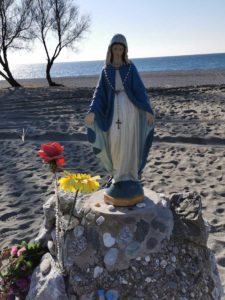 Ich glaube fest an Trauerrituale in der Gemeinschaft. Man muss sie erlebt haben, selbst wenn sie nachgeholt waren – und ich habe viele nachgeholt, weil bei uns zu Hause nicht getrauert wurde. Ich glaube daran, dass sie den Toten etwas geben und ihren Angehörigen. Dass sie denen etwas geben, die Zeug*innen sind; selbst, wenn sie nur davon hören, berührt werden sie sein. Ferner glaube ich fest an die Kraft der Beziehung, die fast die Qualität einer Person, eines Organismus hat. Das heißt, in dem Trauerakt, in der Trauerzeit, lassen wir zu und geben Raum, dass diese Beziehung sich klärt und reinigt. Vielleicht ist ja auch unsere Beziehung zu Gott, zum Göttlichen, Numinosen (neu?) zu betrachten. Leben wir dieses Leben so, wie es gelebt werden will oder gar soll? Der Tod ist ein machtvoller Heiler, der fast nie gelegen kommt. Er lehrt uns weniger über den Tod, als vielmehr über das Leben. Was ist eigentlich schon längst abgestorben in uns? Und was davon kann oder will ich gehen lassen und was will oder muss neu belebt werden?
Ich glaube fest an Trauerrituale in der Gemeinschaft. Man muss sie erlebt haben, selbst wenn sie nachgeholt waren – und ich habe viele nachgeholt, weil bei uns zu Hause nicht getrauert wurde. Ich glaube daran, dass sie den Toten etwas geben und ihren Angehörigen. Dass sie denen etwas geben, die Zeug*innen sind; selbst, wenn sie nur davon hören, berührt werden sie sein. Ferner glaube ich fest an die Kraft der Beziehung, die fast die Qualität einer Person, eines Organismus hat. Das heißt, in dem Trauerakt, in der Trauerzeit, lassen wir zu und geben Raum, dass diese Beziehung sich klärt und reinigt. Vielleicht ist ja auch unsere Beziehung zu Gott, zum Göttlichen, Numinosen (neu?) zu betrachten. Leben wir dieses Leben so, wie es gelebt werden will oder gar soll? Der Tod ist ein machtvoller Heiler, der fast nie gelegen kommt. Er lehrt uns weniger über den Tod, als vielmehr über das Leben. Was ist eigentlich schon längst abgestorben in uns? Und was davon kann oder will ich gehen lassen und was will oder muss neu belebt werden?
Mein Erbarmen mit meinen geliebten Seelenfreundinnen und -freunden, den italienischen Menschen, ist gewachsen. Wie gut, dass wir verdrängen können! Darüber klärte uns die Blumenfrau am letzten Friedhof auf, den wir am Sonntag besuchten, in Reggio Calabria. Oder war es in Messina, und wir hatten den Golf schon überquert? Reporter und Besserwisser gingen ihr gehörig auf die Nerven. Wir beschenkten sie mit unserem „Danklied“ und kauften Blumen.
Der Punkt ist, und ich denke, das erschließt sich aus dem Text, der Fortsetzungen haben wird, wir dürfen Menschenwesen – mit ihnen kenne ich mich am besten aus – (sicherlich auch keine Tiere) nicht einfach verrecken lassen. Das tun wir aber, und wir tun es ohne Not. Wenn man sich einmal auf den Weg begeben hat, die Angst vor bestimmten Manifestationen des Lebens aufgeben zu wollen (Kranke, Alte, Sterbende, Tote: die klassischen Themen im Buddhismus, und ich würde noch hinzuzählen: Arme, Ausgegrenzte, Bettelnde, Fremde), dann führen diese Begegnungen zu tiefen Einsichten und dem Wunsch, Leiden lindern zu wollen, übrigens auch bei uns selber. Womit wir am Anfang wären. Wir lindern das Leiden, indem wir hinschauen. Sehen das Eine Leben. Lassen uns berühren und tun, was das Leben von uns verlangt. Stille Freude kehrt ein.
Kitschig? Probieren Sie es aus, erklären Sie bestimmte Tage oder kleine Reisen zu Pilgertagen. Seien Sie erfinderisch. Wenn wir auf die Geistlichen warten wollen, die Derartiges anbieten, dann können wir lange warten. Ich wollte weder warten noch bitter werden. Sie können mir schreiben oder mich anrufen.
„Unsere Augen waren noch unschuldig“ (aus Davide Enia: Schiffbruch vor Lampedusa).
Reisebericht "Wo sind die Toten" mit Bildern - von Laura und Jana
Videos der Vorträge über die Pilgerreise
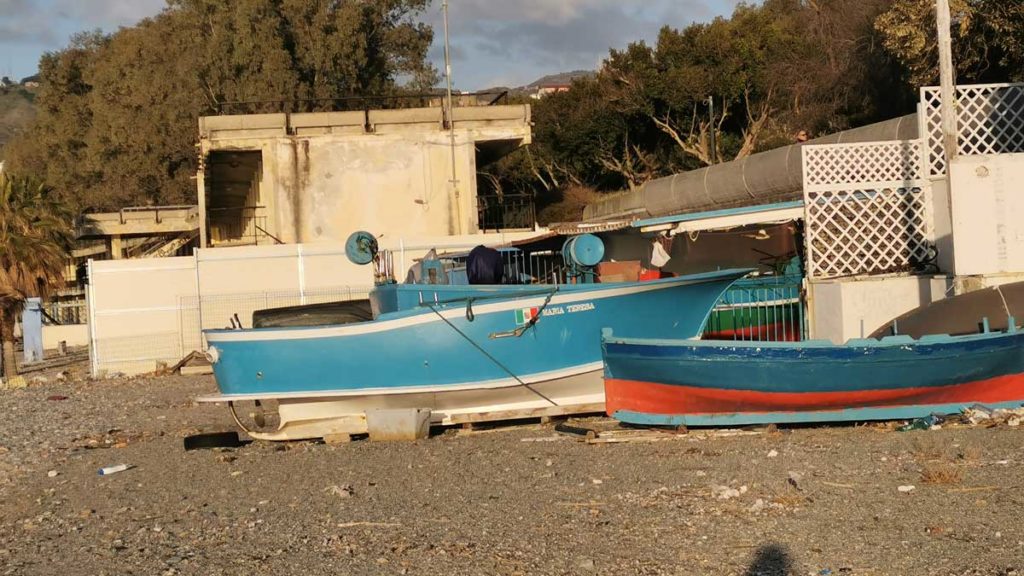
English translation
Innocent Eyes
 From Jan. 7-14, 2020, three women made a pilgrimage to Southern Italy: More precisely, the destination of their trip was the International Cemetery in Tarsia/Calabria, on which the internet only gave few informations. The politically right-wing orientation of the President at that time and some other reasons, which I will tell about in the second part, put the project on hold for the time being. As a Zen Peacemaker and coordinator of retreats and sesshins, I had already been to Lampedusa twice and in between also to Piraeus (not organized by me) to witness firsthand the lives of refugees. In the meantime, their deaths, which are usually more like a staggering, in high numbers, had become even more relevant. But above all, since the captain and human right’s activist Claudia Rackete was on everyone’s lips and in the media, thereby especially present in Lampedusa, I thought, this island is stocked with souls willing to rescue and support, with people who, like me, cannot or do not wish to look away. (Whereby, and this is important for me to emphasize, I see pilgrimages as basically joy-giving good opportunities to let compassion become effective. Yes, joy. I’ll come back to that later.)
From Jan. 7-14, 2020, three women made a pilgrimage to Southern Italy: More precisely, the destination of their trip was the International Cemetery in Tarsia/Calabria, on which the internet only gave few informations. The politically right-wing orientation of the President at that time and some other reasons, which I will tell about in the second part, put the project on hold for the time being. As a Zen Peacemaker and coordinator of retreats and sesshins, I had already been to Lampedusa twice and in between also to Piraeus (not organized by me) to witness firsthand the lives of refugees. In the meantime, their deaths, which are usually more like a staggering, in high numbers, had become even more relevant. But above all, since the captain and human right’s activist Claudia Rackete was on everyone’s lips and in the media, thereby especially present in Lampedusa, I thought, this island is stocked with souls willing to rescue and support, with people who, like me, cannot or do not wish to look away. (Whereby, and this is important for me to emphasize, I see pilgrimages as basically joy-giving good opportunities to let compassion become effective. Yes, joy. I’ll come back to that later.)
So then we could go watching out for that graveyard haunting my mind for years, because my question “Where Do The Dead Actually Go?” who are showing up, already dead, on the shores and beaches of the islands, or who die while still imprisoned in the “hotspots” or who have been suddenly found by horrified fishermen in their nets, shouted for an answer.
This question had already moved me when I saw the photos in the news, in 2014, photos of halls filled with coffins close together, on which lay red roses. It was not possible to keep this up for long in Lampedusa, to give every single arrival a coffin, a grave. I am speaking now of a few impressions from the 1st Bearing-Witness-Pilgrimage to Lampedusa, in September 2014, a month before the memorial-day of the terrible boat accident very close to the coast of the island. Approximately 350 people, including babies and children, had drowned at dawn on Oct. 3, 2013. A fisherman who happened to be out at sea saved dozens with two friends. We should later meet him and talk to him. Mayor Sra. Guisi Nicolini, upon her appointment as Mayor of Lampedusa, gave a moving speech in which those fleeing across the sea took a central role. (The speech will soon be available for download here). When we were in the cemetery to do walking meditation or to sit quietly and pray, contemplating the epitaphs, after a while one could well understand how sincere efforts Lampedusans had been making at the beginning – whenever one dates the beginning – to document who had perished at what age where in the sea. Very touching documents of sympathy and, so to speak, of a reverse hospitality were here – and certainly still are – on the tombstones. But of course this would come to an end, the island is small, the cemetery too. There were graves with multiple names, down to a tiny and dusty field and a wooden cross. If this wooden cross could speak….
You, dear readers, can already guess how puzzle piece piled up on puzzle piece, how my question where the coffins would actually be taken remained unanswered, how I was moved by the shocking statements of young refugee men in Bonn, who reported, again and again, that mothers, aunts, mostly in the night, called and asked for their sons! If they even learned whether their child was still alive or now knew for sure that he or she had died – they desperately wanted to know where this beloved, missing person, their child, was buried! The Syrian people I met, with some of them friendship connected or connects me, were exhausted by these phone calls or other calls, also the few beautiful occasions exhausted them (birthday parties, weddings), because they could not be there.
In January 2020, after many conversations with open, helpful (except one, in a bar in Reggio) Italians, I realized that these questions – although we always affirmed our gratitude and listed what burdens the Italians, and particularly the Southern Italians, Sicilians would carry for us, those from the “rich” North of Europe – that these questions to ask were a taboo.
 Only on the penultimate day of our pilgrimage would puzzle pieces of what we had experienced or observed come together in a meaningful way. By then we had been to numerous cemeteries and had looked around. One of the cemetery employees knew something to tell me.
Only on the penultimate day of our pilgrimage would puzzle pieces of what we had experienced or observed come together in a meaningful way. By then we had been to numerous cemeteries and had looked around. One of the cemetery employees knew something to tell me.
A young employee in the bar at the hotel near Tarsia expressed a fantasy. And last but not least, the enlightening conversations around the old and newly planned cemetery in Tarsia: all this plus an article in the magazine SPIEGEL, which suddenly landed on my cell phone and which I read out in the rented car, gave clear clues to the unspeakable: There were mass graves. Very likely mass burnings. And there were over twenty cemeteries in Sicily whose names we could have gotten on Monday, the day we left for Germany. Their purpose was to hold a certain percentage of dead refugee bodies. Whereby at that point it was already clear where they would be buried: Behind the beautiful tombs in Italy that look like tiny houses, and also still behind the line of beggars and poor people.
I firmly believe in community mourning rituals. You have to have experienced them, even if they were caught up – and I caught up many because there was no mourning in our home -. I believe that they give something to the dead and to their loved ones. That they give something to those who are witnesses; even if they only hear about it, they will be touched. Furthermore, I firmly believe in the power of the relationship with the dead person, which has almost the quality of a person, of an organism. That is, in the act of mourning, in the period of mourning, we allow and give space for this relationship to clarify and purify itself. Perhaps our relationship to God, to the divine, numinous, is also to be (re?) considered. Are we living this life the way it wants to be lived, or even the way it should be lived? Death is a powerful healer that is almost never convenient. It teaches us less about death than about life. What has actually died in us long ago? And what of it can or will I let go and what wants or needs to be revitalized, created?
My compassion for my soul mates, the Italian people, has grown. How good that we can suppress! The flower lady informed us about this at the last cemetery we visited on Sunday, in Reggio Calabria. Or was it in Messina, and we had already crossed the Gulf? Reporters and know-it-alls were getting on her nerves. We gave her our “thank-you-song” with large smiles, and bought some flowers.
The point is, and I think this is clear from the text, which will have sequels, we must not let human beings – I know them best – (certainly not animals either), just die under miserable circumstances. But we do that, and we do it without need. Once one has set out on the path of giving up the fear of certain manifestations of life (the sick, the old, the dying, the dead: the classic themes in Buddhism, and I would add: Poor, marginalized, beggars, strangers), then these encounters lead to deep insights and the desire to want to alleviate suffering, by the way, also in ourselves. Which brings us to the beginning. We alleviate suffering by seeing One Life everywhere. We let ourselves be touched and do what life demands of us. Silent joy will fill us.
Cheesy? Try it out, declare certain days or small journeys as pilgrimage days. Be inventive. If we want to wait for the clergy to offer such things, we can wait a long time. I did not want to wait or become bitter. You can write or call me (+43/228/7443939, m.winkelmann-schreiben@web.de. Donations for Little Temple: PayPal, my address).
“Our eyes were still innocent” (from Davide Enia: Shipwreck at Lampedusa).

Impressum
Datenschutz
Kontakt


